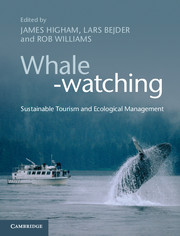Book contents
- Frontmatter
- Dedication
- Contents
- Acknowledgements
- List of contributors
- List of abbreviations
- 1 Tourism, cetaceans and sustainable development
- Part I The historical and contemporary contexts
- Part II Human dimensions of whale-watching
- Part III Ecological dimensions of whale-watching
- 13 Understanding the ecological effects of whale-watching on cetaceans
- 14 Whale-watching and behavioural ecology
- 15 Energetic linkages between short-term and long-term effects of whale-watching disturbance on cetaceans
- 16 Ecological constraints and the propensity for population consequences of whale-watching disturbances
- 17 The use of area–time closures as a tool to manage cetacean-watch tourism
- Part IV Sustainable management: insights and issues
- Index
- Plate Section
- References
13 - Understanding the ecological effects of whale-watching on cetaceans
from Part III - Ecological dimensions of whale-watching
Published online by Cambridge University Press: 05 April 2014
- Frontmatter
- Dedication
- Contents
- Acknowledgements
- List of contributors
- List of abbreviations
- 1 Tourism, cetaceans and sustainable development
- Part I The historical and contemporary contexts
- Part II Human dimensions of whale-watching
- Part III Ecological dimensions of whale-watching
- 13 Understanding the ecological effects of whale-watching on cetaceans
- 14 Whale-watching and behavioural ecology
- 15 Energetic linkages between short-term and long-term effects of whale-watching disturbance on cetaceans
- 16 Ecological constraints and the propensity for population consequences of whale-watching disturbances
- 17 The use of area–time closures as a tool to manage cetacean-watch tourism
- Part IV Sustainable management: insights and issues
- Index
- Plate Section
- References
Summary
Introduction
Whale-watching is a potentially sustainable use of cetaceans and an economically viable alternative to whaling and has become a major contributor to the tourism sector of many countries (Hoyt, 2001; O’Connor et al., 2009). Whale-watching also has the potential to improve people's attitude toward the marine environment, and promote public awareness and support for the conservation issues that targeted species face (Duffus & Dearden, 1993). However, whale-watching can put cetaceans at risk of being harassed and injured by an unknown number of unpredictable impacts which can pose a risk to the viability of the targeted population, as well as the whale-watching industry itself.
Reported effects of human disturbance on ceta-ceans cover a range of taxa, including many odontocete species and several species of mysticetes (see Chapter 16). Even though many studies have shown that whale-watching can cause both short- (Nowacek et al., 2001; Williams et al., 2002b; Lusseau, 2003a; Christiansen et al., 2010) and long-term negative effects on cetaceans (Bejder et al., 2006; Fortuna, 2006; Lusseau et al., 2006b), few studies have focused on explaining the underlying cause, or ecological and evolutionary mechanisms for these effects (Frid & Dill, 2002). Understanding how human interactions affect wildlife is crucial for the sustainable management of any nature-based tourism activity. This chapter address-es the ecological foundations of whale-watching disturbance on cetaceans. It gives an overview of the documented impacts of whale-watching on cetaceans and compares this to observations of natural predation. It then tries to explain how whale-watching is perceived by the animals to understand the underlying ecological and evolutionary basis for these responses. It goes on to discuss different factors that are likely to influence the response of animals to whale-watching. We then discuss the long-term effects of whale-watching on cetaceans by following the mechanistic link between behavioural effects and vital rates within an energetic framework. Ecological and biological constraints to the ability of cetaceans to cope with disturbance are discussed as well as their implication for long-term vital rates.
- Type
- Chapter
- Information
- Whale-watchingSustainable Tourism and Ecological Management, pp. 177 - 192Publisher: Cambridge University PressPrint publication year: 2014
References
- 20
- Cited by



